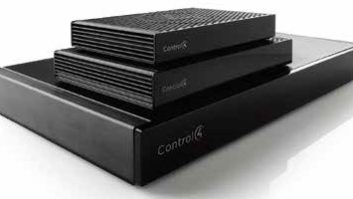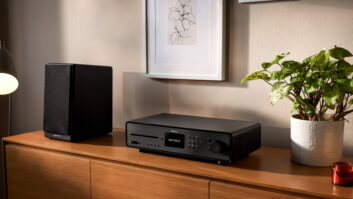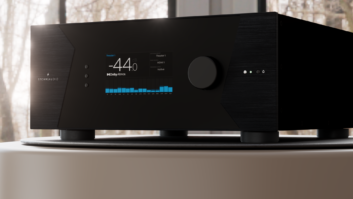Much like how the swallows return to Capistrano or the Monarch butterflies take their yearly sojourn to Mexico to fill up on off-brand, over-the-counter Viagra and worm-filled tequila, AV manufacturers tend to roll-out new models on a predictable, yearly basis.
Usually it is in that golden window for electronics that occurs sometime after CES – January ��� and before CEDIA – September – giving everyone time to get excited about the new models and plan to spec them into projects and editorial timetables. During this time, the sun seems to shine a little brighter, sounds are a little more sparkly and technophiles everywhere have an extra must-have-new-feature bounce and spring in their step.
While many of the model numbers sound like they came from Mister Mxyzptlk’s home world – I’m especially looking at YOU, Sony! – Denon seems to have actually created a numbering system that is simple, understandable, and actually helps you to remember how old something is. I give them a lot of credit for this. *respect*
Denon’s model numbers are AVR – like Audio Video Receiver – then a 2-digit number – like 19 – then another 2-digit number – currently 13. The first number tells you where the unit ranks in the line-up, historically somewhere from 13 to 58; so a 19 isn’t as high performing as a 21 but is better than a 17. The second number is the generation/year-ish. (I say “ish” because this seems to be a year ahead, like maybe it is an expiration as in “this model will be good until the year…” or something. The exception here seems to be with the high-end models that don’t change out as rapidly; for instance, we are still selling the AVR-4311… Look, I said it was a good system, not a perfect one.)
So, you can go back in time and see a Denon model 1600 and know that it is roughly 12 years old and really wasn’t that great of a model. And that a 3308 isn’t too old and is probably pretty feature rich. Capisce?
So, the other day we went to a client’s house to do a service call. My guy gets there and the receiver just keeps clicking off. He disconnects everything, powered the unit back on and *click* it still shuts off. “She’s dead, Jim. Dammit, I’m an AV tech, not a miracle worker!”
So I ask him the model number; it’s an 1804.
Pop Quiz: Who here thinks they know what year that model is from? Hint: It’s not 03 OR 05…
So we tell the homeowner that it really isn’t worth trying to get it repaired, that the new model is a 1913, is a quantum improvement in technology and that we can come back and install it for them. The homeowner is on the trolley with this idea, so we schedule a time to come back.
And when we unbox the new model, it is amazing how drastically the state of audio/video has changed in the past 9 model cycles. And not just changed, but how new gear has almost completely disenfranchised owners of older gear. If you replace your AV receiver, it is quite possible that you may have to also REPLACE THE MAJORITY OF YOUR SYSTEM! This is not cool, turning what could be a simple, “Here’s your invoice for a new receiver” into a “Here’s your invoice for a new receiver. And Blu-ray player. And cable box. And TV. And tons of rewiring. And reprogramming.” Now, I am using Denon as an example here because it is the situation I was faced with, but this is pretty much the case amongst all major brands.
So, here is a picture of the front of the AVR-1804, a model that sold for about $499.

Lots of little buttons and knobs and indicators and things. But what I really like about this is that I can have a person read me what is going on inside that LCD panel and then usually diagnose the problem over the phone and offer a suggestion for a fix. “Push this button. What does it say now? OK, now push this button. Fixed? Yay! Yes, you’re right, I am a genius. Thank you. Sure, you can name your next child after me. And any decent single malt will do, preferably from the highlands. You’re welcome.”
Here’s the front of the new AVR-1913, a model that currently sells for $579. Also, whereas the old one came in a utilitarian, brown cardboard box with simple, no-frills lettering, this new one comes in a fully four-color box with feature comparisons to other models. Nice!

Plain. Streamlined. Sleek. Classy. Basically one big (volume) knob and a couple of buttons. Sure, it’s prettier and less fussy to look at, but from a troubleshooting standpoint, it doesn’t give me as much information and will require more button pushes* from the homeowner.
(* Note: I consider every homeowner button press to be another round of Russian Roulette. Each press of a front panel button comes with at least a 49% risk of them messing something up worse than the original problem we were trying to correct.)
But, that’s really just aesthetics, and I can embrace change and improvements in cosmetic design. The real story is around back. Check out the back of the AVR-1804:

Look at the back of that thing! It’s like the Starship Enterprise, you know, if the Enterprise were an older, mid-level AV receiver with banana plugs instead of photons. For a sub-$500 receiver back in 2004, that is a pretty fully featured model. You’ve got both speakers A and B, surround back or Zone2 channels, 2 in/1 out component video; 4 in/3 out S-Video (the most hated, and accursed of all video connectors! Forged in the deepest bowels of Hades by the soot covered, cloven hooves of Lucifer himself!) 4 in/3 out Composite video; 4 separate digital audio inputs and 1 output; a 6 channel analog input; a Phono input; 6 analog audio inputs with 3 outputs and a Zone 2 output. And a mini-jack IR input. That is a pretty impressive list of options for under five Benjies. And there were very few systems back in 2004 that this wouldn’t service.
So, imagine that this is the unit you are taking out of a job. Your client has an existing DVD player and HD cable box connected to it, and wired to the TV via component video, as was the practice of the day. Oh, and the component cable run goes through cabinets and walls and hither and yon to get to the TV. You’re also using the audio outputs to feed an amplifier to drive a housewide audio system because that’s how you do.
So, you unbox the brand new model which sells for $579 and flip that bad girl around and see this:

Where the hell did all the connections go?!? This looks like an entry level model from 1999 (albeit in an alternate universe where we discovered HDMI in 1999. I’m hopeful that that universe didn’t struggle with the growing pains of HDCP issues and that “plug-and-play” rarely wasn’t and the constant version changes…)
Oh, sure, there’s tons of HDMI inputs, but if you bought any gear that is older than like 4-5 years, it probably doesn’t have any HDMI outputs. We’ve lost Speakers B which can actually be pretty useful in some situations. But that isn’t the end of the world. (Unless you were actually USING the B-speakers, of course…)
More importantly we have only ONE component video input. Oh, and great news! NO component video OUTPUTS. So, looks like you’ll be rewiring stuff, buddy. What’s that? Your existing TV doesn’t have an HDMI input? Looks like you’re buying a new set too! What? The cabinetry was custom made for this set? Umm, uh, yeah. That DOES suck. What’s that? There’s nothing I can do? Well, I could connect everything via composite video and you can say “Adios, muchachos!” to HD programming. So, we have a total of 3 connections – only one of which is HD — for legacy video sources yet only a non-HD video output. To get back to a similar number of video connections from our 04 model you have to go up to a $899 model in Denon’s current line-up.
(You’ll notice that I’m not bemoaning the loss of S-video. That’s because this is such a hateful connection that if the whole system HAD been wired with S-video to begin with, you have been looking for any good excuse to rip it out and replace it, so you should be dancing a little jig at this point. Go on. Rip those spiteful S-video cables out and use them to tie up your yard debris!)
Also slashed is the number of digital audio connections; we’re now down to two. So how do we connect the legacy gear gear? Umm, we pick your favorite two…?
We have four analog audio inputs which is usually sufficient, but we have NO outputs! How do we feed our existing amplifier to drive the rest of the house? How?!?
So, while the new receiver is packed with a bunch of awesome features – Network connectivity, streaming Pandora and Spotify and such, Audyssey room calibration, cool iPad app, Control4 certified, Dolby IIz height processing, way better D/A conversion – it is really a future generation product that looks ahead while turning its back on the past.
Moral of the story: If you have – or are replacing – an older existing receiver, you might be biting off more than you planned and it’s a good idea to figure out all of the features and connections the client is using before you go spec’ing in a new model.
Verily, John hath spoken. (Or written.)






